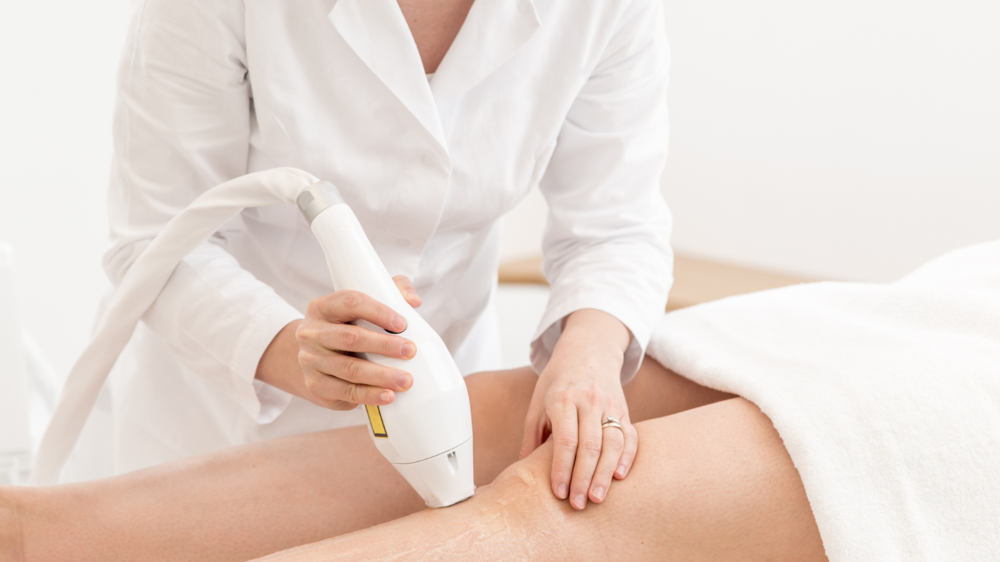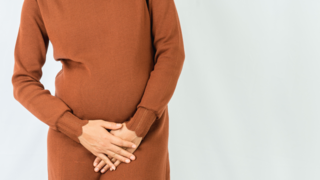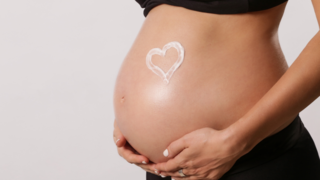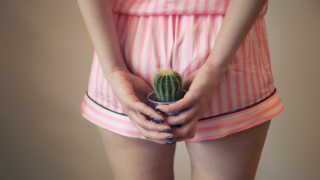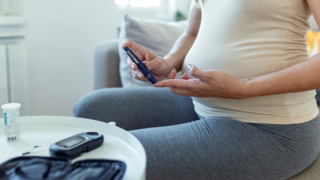In this article:
Two common options, laser hair removal and bikini waxing, are frequently debated for their safety during pregnancy. Understanding the risks, benefits, and alternatives can help you make informed decisions about managing unwanted hair while keeping you and your baby safe.
Laser Hair Removal During Pregnancy
Laser hair removal involves directing a concentrated beam of light at hair follicles, targeting the pigment to generate heat that damages or destroys the follicle. This process reduces future hair growth. This method is popular for long-term hair reduction. While laser hair removal is not recommended during pregnancy, it is not because the procedure is unsafe; it is simply due to the lack of clinical research in this area. Most dermatologists choose to defer it until after childbirth out of precaution, not concern.The absence of studies is due to the ethical concerns about testing potentially risky procedures on pregnant individuals, as no scientist wants to jeopardise the health of you and your foetus. During pregnancy, increased skin sensitivity, higher blood flow, and hormonal fluctuations can make treatments less comfortable and potentially less effective. Temporary pigmentation or irritation, although rare, may also occur. These factors contribute to why experts prefer postponing laser treatments until postpartum.
It is also important to understand that laser hair reduction doesn’t eliminate 100 per cent of hair permanently. Instead, it significantly reduces hair density and slows regrowth over time, with only occasional touch-ups needed after the initial sessions.
Potential Risks of Laser Hair Removal During Pregnancy
There are many potential risks of laser hair removal during pregnancy. Lasers emit radiation, which could pose a threat to the developing foetus. It is particularly true in the first trimester when organs are forming. High doses of radiation might increase the risk of complications like miscarriage or foetal malformations.Some other risk factors include:
- Pregnancy hormones, like increased oestrogen and androgen levels, can affect the hair growth cycle. These changes may prolong the active growth phase (anagen) and delay the transition to the resting phase (telogen). Since laser hair removal is most effective during the anagen phase, hormonal changes may reduce its efficacy. You might require multiple sessions that might not give the desired results.
- Pregnancy increases blood flow and makes the skin more sensitive. This can make treatments feel more uncomfortable and potentially lead to side effects like skin irritation, burns, blistering, scarring, or changes in skin colour.
- Hyperpigmentation, a common pregnancy-related condition where the skin darkens, can also complicate laser hair removal. The procedure works best when there’s a strong contrast between your skin and hair colour. However, hyperpigmentation may reduce this contrast, reducing its effectiveness.
- Pregnant individuals are also more susceptible to infections due to a weakened immune system, which heightens the risk of complications from any skin irritation or burns caused by the laser.
- If you’re breastfeeding, the same precautions apply. There’s no research confirming the safety of laser hair removal on breast milk or the baby’s health. So it's best to wait until you’ve finished breastfeeding.
If you’ve already started laser hair removal and are trying to conceive, consult your doctor before continuing. An early pregnancy might expose you to risks before you’re aware you’re pregnant.
Bikini Waxing: A Safer Option?
Bikini waxing, which removes pubic hair using hot or cold wax, is another option for managing hair growth during pregnancy. Unlike laser hair removal, bikini waxing is generally considered safe, provided you take precautions to minimise risks. The procedure helps keep the intimate area clean, reduces the risk of infections, and controls rapid hair growth.It also offers longer-lasting results compared to shaving or hair removal creams. This makes it an appealing option as reaching certain areas becomes challenging with a growing belly.
Potential Side Effects of Bikini Waxing
Although bikini waxing is generally safe during pregnancy, it can have drawbacks due to increased skin sensitivity. Some potential side effects include:- Hormonal shifts and increased blood flow can make the vaginal area more tender, causing waxing to be more painful than usual.
- The process may also lead to rashes, itching, or burns if the wax is too hot. This could potentially disrupt the vaginal pH balance.
- Sensitive skin is prone to tears or cuts, which could result in infections like folliculitis, boils, or abscesses if not properly managed.
When is the Safest Time to Get a Bikini Wax During Pregnancy?
Timing is important when considering bikini waxing during pregnancy. The second trimester is often the best time, as sensitivity may be lower than in the first or third trimesters. Avoid waxing in the last one to two months of pregnancy, especially in the pubic area. This can help reduce the chances of infections or discomfort as your due date approaches.Doctors also advise against waxing the lower belly or pubic region immediately before delivery, particularly if a caesarean section is planned. Small nicks or cuts from waxing could increase the risk of infection at the incision area.
Alternatives for Hair Removal During Pregnancy
Considering the uncertainties around laser hair removal and the potential discomfort of waxing, there are several safer hair removal methods to choose from during pregnancy.- Shaving is a straightforward option for larger areas like legs and arms. Use a fresh blade, shaving cream, and gentle strokes in the direction of hair growth to prevent irritation.
- Plucking and threading are ideal for smaller areas like eyebrows or the upper lip. Plucking is simple for at-home touch-ups.
- Hair removal creams, such as those formulated for sensitive skin, are another option, but should be used cautiously. There’s no definitive research proving the safety of chemicals used in these creams, like barium sulphide powder or thioglycolic acid, for pregnant individuals. Always discuss these products with your doctor before use.
Postpartum Hair Removal Considerations
After delivery, your body continues to adjust as hormones gradually return to normal. This often leads to a temporary hair loss condition called telogen effluvium three to six months postpartum. This is a normal response to the hormonal shift, and most pregnancy-related hair growth resolves on its own.Once your body begins to stabilize, laser hair reduction becomes an excellent option. It is safe, non-invasive, and only targets the hair follicles, with no effect on internal organs, hormones, or future fertility. It offers long-term results with minimal maintenance, making it a convenient and effective choice for new parents managing recovery and a busier lifestyle.
Before resuming laser hair removal or bikini waxing, consult your healthcare professional to ensure your hormones and skin are ready. Taking proper consultation is important if you’ve had an episiotomy or caesarean delivery, as wounds or incisions need time to heal.
For laser hair removal, wait until after breastfeeding to minimise any potential risks to your baby.
Practical Hygiene and Safety Tips
To maintain intimate hygiene and manage hair growth safely, follow these tips.- Keep the vaginal area clean and dry.
- Choose breathable cotton underwear, and stay away from tight clothing or shapewear that could irritate the skin.
- In the third trimester, consider using panty liners to manage urine leaks.
- If waxing, prepare your skin by ensuring hair is about a quarter-inch long. Gently exfoliate to prevent ingrown hairs.
- Post-waxing, wear loose clothing and avoid hot showers. Apply oil-free moisturisers to calm the skin.
FAQs on Is Laser Hair Removal and Bikini Wax Safe During Pregnancy
- Is laser hair removal safe during pregnancy?
No, it’s advised to avoid laser hair removal during pregnancy because there is insufficient research on its safety and possible risks to the developing foetus. - Can I get a bikini wax during pregnancy?
Bikini waxing is generally considered safe during pregnancy, but increased skin sensitivity can make it more painful. Make sure you go to a licensed technician for safety. - When is the best time to get a bikini wax during pregnancy?
The second trimester is the ideal time for bikini waxing because skin sensitivity is lower than in the first and third trimesters.

